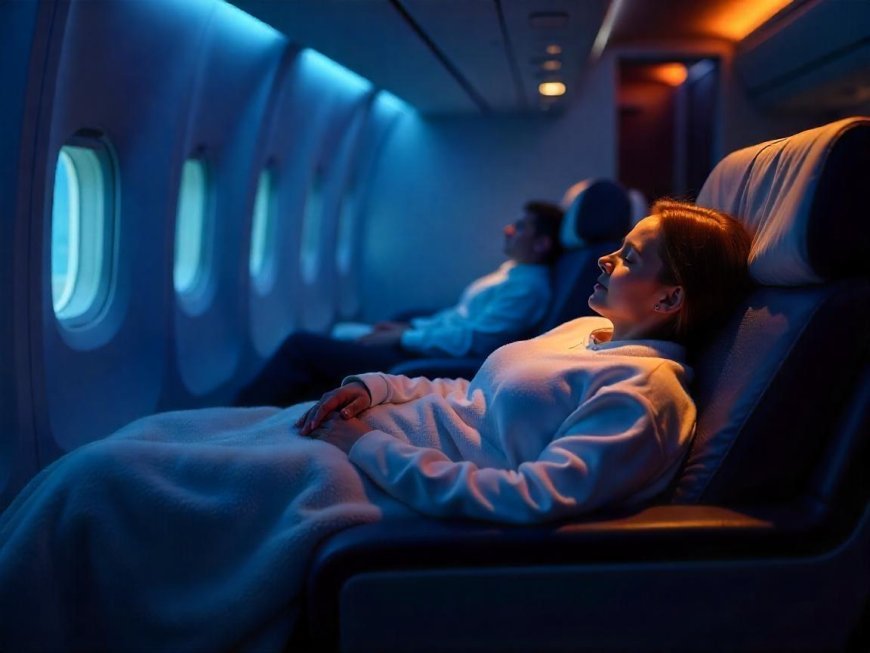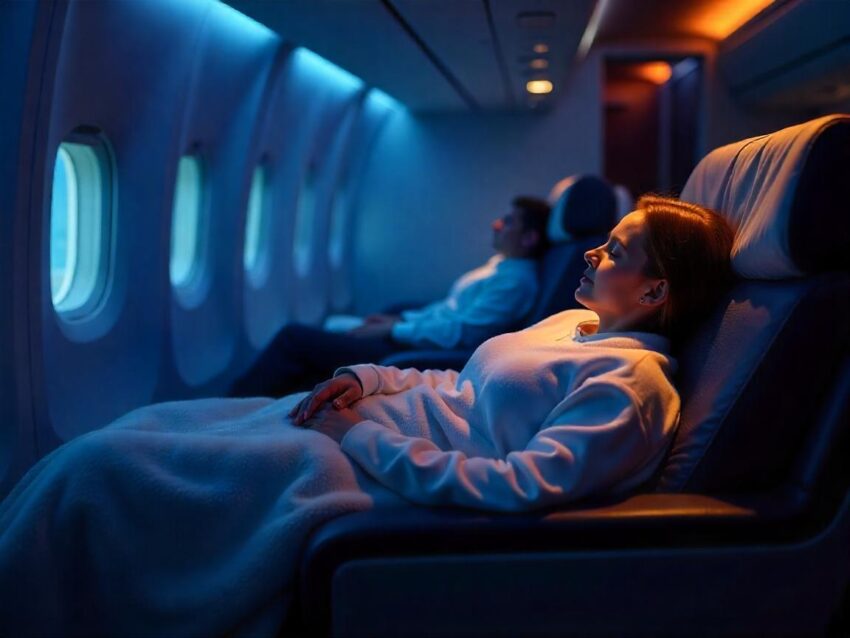How American Airlines Competing with Air Canada, AirFrance, Delta, United, Virgin Atlantic in Redefining New Premium Travel Experience When in Flight, New Development is Here


American Airlines is stepping into the premium travel spotlight with a quiet confidence that’s beginning to turn heads. While competitors like Air Canada, Air France, Delta, United, and Virgin Atlantic make bold moves with high-profile cabin reveals and media campaigns, American is taking a more understated—but no less impactful—approach. The airline is rolling out advanced in-flight upgrades, including redesigned business class suites, enhanced connectivity, and elevated lounge experiences.
These changes reflect a clear shift in strategy: to compete not just in seats and service, but in creating a premium journey that feels seamless, modern, and personal. As global carriers raise the bar for in-flight luxury, American is no longer content to trail behind. A new wave of fleet improvements and passenger-focused innovations signals that AA is ready to challenge the elite in the skies—offering travelers a refreshed and refined experience that speaks quietly but delivers confidently.
American Airlines Redefines Premium Travel
In an era where airline brands compete loudly for attention, American Airlines is taking a different route. The world’s largest airline by fleet size is undergoing a quiet transformation—upgrading cabins, improving lounges, and installing high-speed WiFi across its fleet. But unlike Delta and United, American isn’t shouting about it.
This strategic silence could be holding AA back from reshaping its public perception, even as the airline introduces some of the industry’s most competitive premium products.
Next-Gen Cabins Take Flight Without the Hype
American Airlines is rolling out new business class suites that rival, if not surpass, the competition. The Adient Ascent seat, found on its new Boeing 787-9 aircraft, delivers an upgraded long-haul experience that blends sleek design with comfort and privacy.
These flagship suites are being introduced gradually across AA’s long-haul routes, offering high-end travelers a more competitive and luxurious product. Yet, older aircraft like the Boeing 787-8 and 777-200ER are still flying with outdated cabins. Without a full-fleet retrofit, the premium experience remains inconsistent—something rival carriers have been quicker to address.
American’s premium economy offering also stands out for design and comfort, yet it too suffers from underutilization due to a lack of retrofit investment across the older fleet.
WiFi That Works—But Travelers Don’t Know It
Unlike United, which is still working to roll out its Starlink WiFi, American has already achieved something rare: consistent, high-speed connectivity across most of its mainline and regional aircraft.
This makes AA one of the few airlines where travelers can reliably stream, work, and stay connected from gate to gate. Yet with little marketing or in-flight promotion, even frequent flyers often remain unaware of this major advantage.
This is a missed opportunity. In a digital-first world, reliable connectivity isn’t a luxury—it’s an expectation. And American has quietly met it.
Lounge Life Upgraded—But Not Widely Shared
American’s Admirals Club lounges have seen a subtle transformation in key airports like Philadelphia and Austin. From refreshed interiors to upgraded food and beverage offerings, the passenger experience is clearly improving.
Notably, the lounge at Ronald Reagan Washington National Airport set a new benchmark, offering a refined blend of modern aesthetics and comfort. But without a consistent network-wide rollout or visible brand campaign, these improvements remain hidden gems.
Delta’s Sky Clubs, by comparison, are relentlessly promoted and centrally positioned in its brand identity. American’s more restrained approach keeps its enhancements under the radar—even for its most loyal customers.
How Flagship Carriers Are Elevating Luxury in the Skies
Premium Travel Enters a Bold New Era
Premium travel is being redefined. Around the world, airlines are entering an arms race not just for market share, but for experience supremacy. From enclosed suites in the sky to AI-driven concierge services and wellness-focused cabins, today’s top carriers are transforming what it means to fly premium. This isn’t about a better seat anymore. It’s about emotional resonance, personalization, and redefining luxury from gate to landing.
As travel demand soars post-pandemic, business and first-class cabins are emerging as the most dynamic battleground. Airlines are reinvesting in products that deliver far more than comfort—they deliver identity, loyalty, and aspiration. Here’s how the world’s leading airlines are reshaping the future of high-end travel.
Business Class, Reimagined: Suites, Doors, and Privacy Take Center Stage
Business class today looks nothing like it did a decade ago. Lie-flat seats have become the baseline. Now, carriers are competing with full private suites, sliding doors, and innovative seating layouts.
Flydubai, for example, has launched a business class suite on its Boeing 737 MAX fleet, offering lie-flat beds with full aisle access—a bold move for a narrow-body carrier.
Etihad Airways’ new A350-1000 Business Suite features wireless charging, customizable lighting, and privacy-enhancing walls. Cathay Pacific’s upcoming Aria Suite offers sliding doors and 24-inch 4K screens. United Airlines is rolling out its Polaris Studio Suites, designed for maximum personal space and comfort.
American Airlines is introducing its Flagship Suite across the Boeing 787-9 fleet, boasting chaise lounges and wireless charging. Meanwhile, Singapore Airlines is planning future-forward suites with biometric lighting and touch-free cabin experiences launching by 2026.
This race to privacy and control isn’t just innovation for its own sake. Post-pandemic travelers want space, cleanliness, and autonomy. Airlines are delivering.
First Class: From Elite to Experiential
First class is returning to relevance—not as a business class upgrade, but as a destination in itself. Flag carriers are going all in on ultra-premium experiences that fuse hospitality, wellness, and personalized attention.
Air France’s new La Première cabins include sliding walls, chaise lounges, and dual 32-inch 4K displays, delivering a Parisian apartment-like experience. Emirates continues to lead the field with fully enclosed suites, onboard shower spas, minibars, and mood lighting on its A380s and 777s.
United Airlines is upping the ante with caviar service and luxury sleepwear in Polaris. Qatar Airways’ QSuite remains the gold standard for flexibility, with modular seating that transforms into double beds or social spaces.
Airlines are recognizing that affluent travelers want exclusivity without compromise. As such, first class is being elevated to a realm of curated indulgence.
Premium Economy Becomes the New Sweet Spot
Once overlooked, premium economy is now the fastest-growing cabin class globally. It offers a compelling balance of comfort and cost, especially for leisure travelers and digital nomads.
Virgin Atlantic was voted the World’s Best Premium Economy in 2025, praised for generous seat pitch, bespoke catering, and attentive service. Delta leads North America in this category, while Singapore Airlines, Japan Airlines, and Emirates have all refined their offerings.
Airlines like EVA Air, Air Canada, and Lufthansa are also investing heavily in premium economy design, knowing that middle-class travelers increasingly expect more from their journey.
Seats in this class now come with expanded recline, leg rests, personal storage, and upgraded menus. Travelers want premium value without first-class pricing—and airlines are listening.
Wellness and Tech Shape the In-Flight Future
The modern premium traveler wants more than luxury—they want balance. In response, airlines are integrating wellness into every touchpoint of the journey.
Qatar Airways and Emirates offer guided meditation sessions and wellness-focused menus. Singapore Airlines is experimenting with circadian lighting to reduce jet lag. Biometric check-ins and mood-sensitive lighting are becoming standard across next-gen aircraft.
Technology is also reshaping connectivity. Virgin Atlantic now offers free WiFi and AI-driven concierge support throughout the journey. American Airlines already has high-speed WiFi across most of its fleet, outperforming competitors in coverage and consistency.
United Airlines is pushing innovation with Starlink internet, offering streaming-quality access even at 35,000 feet. Travelers no longer view in-flight connectivity as a perk—it’s a baseline expectation.
Airlines Embrace Brand Identity Through Premium Design
Design is now a powerful language in aviation. Airlines are using premium cabin aesthetics to express their cultural DNA. From mood lighting inspired by Scandinavian winters to fabrics woven with local symbolism, every detail tells a story.
Emirates leans into opulence, with gold finishes and marble-effect bathrooms. Japan Airlines opts for minimalism and calm. Turkish Airlines integrates Ottoman patterns and Turkish coffee service into its new lounges and long-haul cabins.
These design choices are not random. They create brand stickiness and help travelers form emotional bonds that transcend the ticket.
The Future: Emotion Over Status
The premium cabin of the future will be defined not by who you are, but how you feel. Emotional design, tech-driven personalization, and sustainability will be the new criteria for value.
Expect cabins that adapt to your mood, meals that align with your biological clock, and AI that learns your preferences flight after flight. The race will be to own the traveler’s emotional journey.
As travelers evolve, so too must airlines. The industry is now competing not just for market share, but for emotional relevance. Premium travel is no longer a category. It’s a statement of intent.
For travelers around the world—from Silicon Valley execs to Middle Eastern royalty, from Canadian entrepreneurs to Southeast Asian creatives—the skies are becoming more meaningful, more human, and more extraordinary.
This is not just a golden age of aviation. It’s a soulful one.
A Communication Gap That Costs Brand Value
While the physical upgrades are commendable, American’s biggest challenge is narrative control. Delta has built an empire on emotional storytelling and consistency. United continuously markets itself as a tech-forward innovator, pushing its Polaris cabin and future-forward initiatives like Starlink WiFi.
American, meanwhile, finds itself caught between two identities. On one hand, it pursues cost efficiency with dense cabin configurations. On the other, it wants to compete in the premium space with high-quality hard products. This split identity creates confusion—not just for passengers, but for employees who often don’t have full visibility into the airline’s evolving strategy.
The result is a brand that is doing the work—but not telling the world.
Passengers Feel the Upgrades, But Miss the Message
American’s improvements are real, and travelers who experience them are often pleasantly surprised. But in a travel environment where perception shapes loyalty, quiet improvements may not be enough.
Customers want transparency, consistency, and a sense of reward. When rivals are broadcasting their wins across social media, in-flight entertainment, and digital campaigns, staying silent creates a vacuum. And in that vacuum, brand loyalty can fade.
The post How American Airlines Competing with Air Canada, AirFrance, Delta, United, Virgin Atlantic in Redefining New Premium Travel Experience When in Flight, New Development is Here appeared first on Travel And Tour World.






